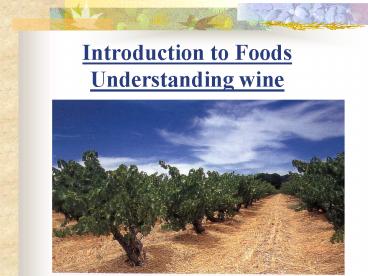Introduction to Foods Understanding wine - PowerPoint PPT Presentation
1 / 18
Title:
Introduction to Foods Understanding wine
Description:
Understanding wine. Alcohol Defined ... Wine Defined most people use the ... A. Still wine if there are traces of CO2 remaining from fermentation process ... – PowerPoint PPT presentation
Number of Views:197
Avg rating:3.0/5.0
Title: Introduction to Foods Understanding wine
1
Introduction to FoodsUnderstanding wine
2
Alcohol Defined
- easiest method refers to a OH bond (hydroxyl)
linked to a carbon structure (hydrocarbon)
3
- used in a number of applications1.
Industrial (ethanol in pure form)2. Chemical
(denatured alcohol)3. Cooking (difficult to
consume)4. Pharmaceutical5. Beverages (ethanol)
4
Beverage alcohol
- result of fermentation from the yeast or
bacteria on sugar to make ethanol by
products of fermentation produce taste also
can convert starch to sugar (enzymes)
5
Wine Defined
- most people use the following definition
the product of the alcoholic fermentation
of the juice of the grape not true in some
cases
6
Wine classified into the following groups
- 1. Table Wines no additives allowed
low amounts of preservatives allowed (sulfur
dioxide) low amounts of conditioners allowed
(used to improve characteristics - eggs,
clay) must be 8 to 14 alcohol by volume
7
2. Pop Wines (Baby Duck)
- use Concord grapes which have powerful
taste grape juice diluted, sugared,
fermented, diluted, sugared and artificially
carbonated grape normally thinned 300 by
end of process
8
3. Carbonated Wines
- three classesA. Still wine if there are
traces of CO2 remaining from fermentation
process B. Crackling wine (1-3 ATM CO2
pressure)C. Sparkling wines (3-5 ATM)
must be natural from secondary fermentation
9
4. Fortified wines
- all natural flavorings used pure grain
alcohol added after fermentation to raise alcohol
(17-20) examples are sherry, Madeira,
port Mistelle pure unfermented grape juice
with pure alcohol added
10
5. Other wines
- A. Fruit wines fermented fruits tend
to be sweet B. Flavored wines addition of
herbs, spices, botanical substances, fruit juices
or a flavoring preparation examples -
vermouth, kirsch C. Honey Wine fermented
honey also known as Mead
11
Definition of an Alcoholic
- person who consumes 135 ml or app 4 oz of
alcohol per day equivalent of 20 light
beers, 10 regular beers or three bottles of wine
12
Metabolization
- only 20 is absorbed in the stomach,
remainder in small intestine relaxes pyloric
valve separating stomach and intestine 90
metabolized by liver 10 removed by breath,
sweat or urine
13
- two parts to process initially acts a
diuretic changes to vasopressin antagonist
or antidiuretic rebound effect know as
bloating retention of water after
metabolization has occurred
14
Hangover
- retention of water resulting in increased
fluid pressure on the brain
15
Liver function
- ethanol converted to acetaldehyde
ketosis (bad breath) body able to metabolize
.1g per Kg body weight per hour rate tends
to be faster in men
16
Turner Formula
- maximum consumption per day is .8g ethanol
per Kg body weight or 80 g per day for all
for any 3 day period .7 g per Kg per day
17
Easy formula (in Lb.)
- body weight / 9 for wine body weight /
30 for spirits body weight / 3.2 for beer
18
Understanding Wine Labels
- need to understand the following1. grape
type2. growing conditions3. region of
production4. label classifications5. service
concerns GrapeVarieties.htm































